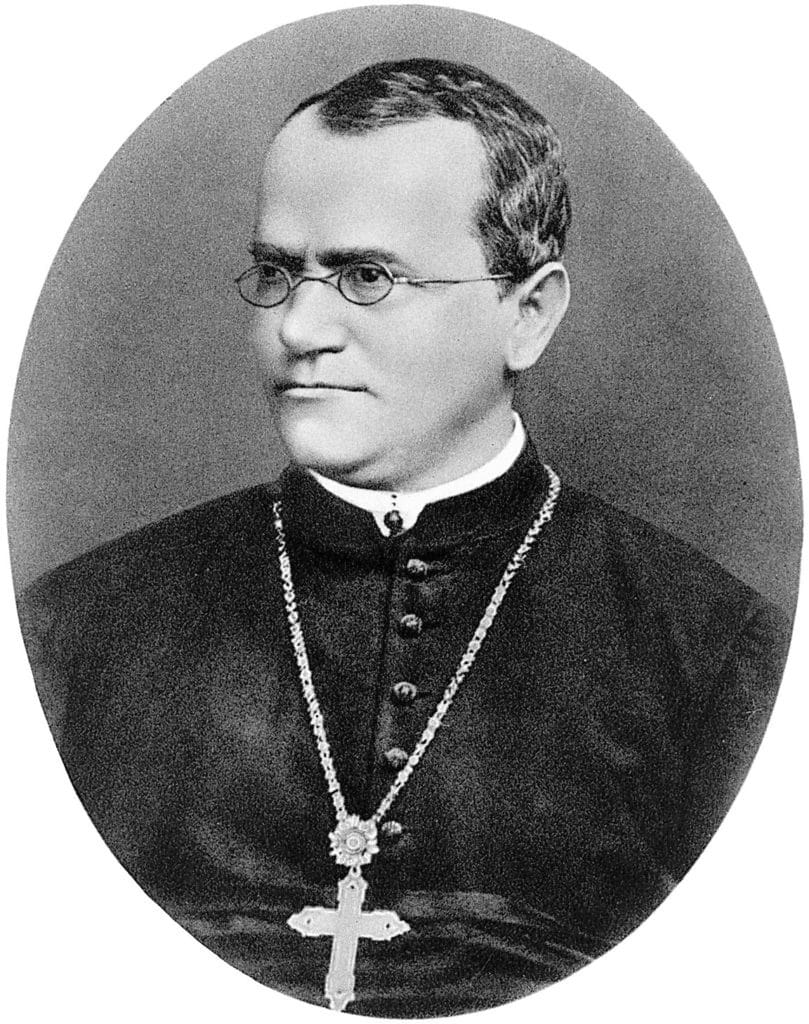
Johann Mendel, later given the name “Gregor” was born on July 20, 1822 in Silesia (in the modern-day Czech Republic). During his childhood, he worked on the family farm and studied beekeeping. Between 1840 and 1843, he studied philosophy and physics at the Philosophical Institute of the University of Olmütz. Lacking the funds to pay for his own education, Gregor joined a monastery where, in his words, he was spared the “perpetual anxiety about a means of livelihood.” His work in the Department of Natural History and Agriculture involved him in extensive research on the hereditary traits of plants and animals, particularly sheep. This led to his entry into the Augustinian St Thomas’s Abbey in Brünn (now Brno, Czech Republic) where he served as a substitute high school teacher while training for the priesthood.
In 1850, Father Gregor Mendel failed his teacher certification examinations. His lowest mark was in biology. Though uncertified, he was permitted to teach natural science as a substitute teacher at the technical high school in Brno, To secure a regular teaching position, he would need to retry the teacher certification examination. To this purpose, in 1853, he immersed himself in the study of the natural sciences at the University of Vienna. When Mendel presented himself in 1856 for the three-day examination, he was study-weary and suffering examination anxiety. On the day of the oral examination, he became embroiled in an acrimonious disagreement with the biology examiner. This unfortunate incident resulted in a second and permanent failure to secure his teaching certificate. As in Darwin’s case, Mendel’s failure to pass an examination was a watershed event that would change the direction of his life and lead to a scientific breakthrough of epoch-making proportion.
Dejected by his failure, at the age of 34, Mendel returned to his substitute teaching job at St. Thomas’s Abbey in Brno, and the central passion of his life–gardening. Father Mendel was fascinated by the mechanism of heredity that passes the traits of a parent to its offspring–the very question that would confound Darwin a decade later. Searching for strains of pea plants that would breed “true”, i.e., produce offspring with traits identical to the parent, he cross-pollinated various varieties of pea plants in the monastery greenhouse. How did he do this?
Pea plants are typically self-pollinating. The pollen from the anther (the male part of the plant) drops onto the stamen (the female part) fertilizing it. To cross-pollinate a pea plant, Mendel had to perform a vasectomy on the plant by snipping off its anther, and then fertilize it by brushing on pollen from another plant. The entire process involved meticulous snipping and dusting. Though the entire monastery was celibate–plants and people–the gardens flourished. Eventually, Father Mendel had a large number of true-bred pea plants that when “mated” with other true-bred pea plants of identical traits, yielded offspring with the parents’ identical traits.
In the process of creating true-bred pea plants, Gregor Mendel used up all the space in the greenhouse and was forced to expand into the monastery garden to continue his experiments. He spent endless hours shelling peas, and comparing pea plants with respect to 7 different pairs of characteristics such as: tall vs. short and green seeds vs. yellow seeds. In the “tall vs. short” experiment, he began with two kinds of pure plants; i.e., those that came only from generations of tall plants and those that came only from generations of short plants. When he “mated” pure tall plants with pure short plants, the offspring were always tall. But when the tall plants of the second (hybrid) generation were mated, he discovered that about one in four of these second-generation plants were short.
Mendel reported the results of these experiments in 1865 to the Natural Science Society at Brno in a paper titled, Experiments in Plant Hybridization. One of his observations was that “hybrids [when “mated”] form seeds having one or the other of two differentiating characteristics.” Though this hypothesis would ultimately lay the foundations for the modern theory of genetics, his paper was received with modest enthusiasm by a gathering of about 40 people. Apparently, the arcane nature of Mendel’s graphs, charts, and tables mystified his audience who failed to realize that he had discovered the indivisible “elements in the periodic table of hereditary traits.” Several decades passed before his work was re-discovered and he was crowned “the Father of Genetics,” but Mendel never lived to see the validation of his work.
